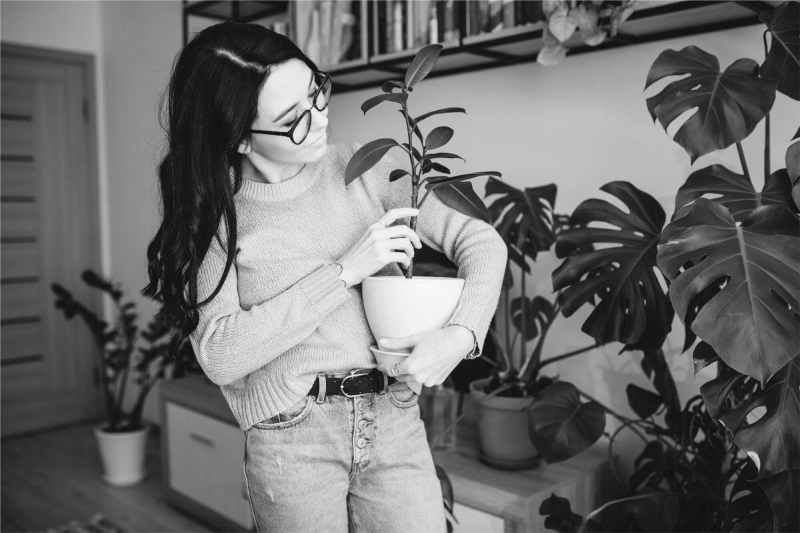Plants have an exceptional ability to breathe life into their surroundings. This ability can turn any living place into a more lively and tranquil retreat.
However, many people feel unsure about where to begin or how to effectively decorate their homes with plants. Should they choose aesthetic-looking plants, collections of succulents, or eye-catching larger ferns? And how can they maintain the health and prosperity of their greenery?
This article explores the numerous benefits of indoor plants, their role in enhancing home aesthetics, and practical tips on how to decorate with them. Whether you own a home, rent an apartment, or simply love interior design, plants can be the perfect element to infuse beauty and vitality into your surroundings.
Learn everything about decorating with plants in the sections below.
Benefits of decorating with plants
Adding good plants to your home does more than enhance its aesthetic. Here are some notable benefits of indoor plant decor.
Enhances visual appeal
Beautiful indoor plants have rich natural textures, lush greenery, and organic movement, creating a lively and welcoming atmosphere in your home. Their natural texture adds tactile richness to your space.
For instance, adding moss decoration creates a tactile, earthy element that enhances the natural aesthetic of your room.
Incorporating a variety of plants, such as Monstera, Bird of Paradise, and philodendron, indoors may transform your spaces into lush, verdant spaces. Dynamic forms of plant decoration, such as cascading aesthetic vines or arching leaves, also add organic movement that makes spaces lively.
Integrating these elements creatively will enhance the visual appeal of your home.
Improves air quality
Plants are natural air purifiers that can absorb toxins and improve indoor air quality with their unique mechanism.
Some varieties have been proven scientifically to improve air quality.
- Snake Plant (Dracaena trifasciata)
- Chinese Evergreen (Aglaonema commutatum)
- King of Air Plant (Tillandsia xerographica), and
- Spider Plant (Chlorophytum comosum)
Snake Plants and Chinese Evergreens effectively absorb volatile organic compounds (VOCs) such as benzene, formaldehyde, and xylene. King of Air Plant and Spider Plant also decrease the concentration of CO2 in rooms.
Promotes relaxation and mental well-being
Studies have shown that having indoor growing plants inside your home leads to reduced stress and a calming atmosphere.
People who spend time around indoor plants tend to have lower diastolic blood pressure, which is linked to feeling calmer and more relaxed.
Higher humidities also create lush, calming indoor environments for people. Plants like the Flamingo Flower (Anthurium andreanum), Devil’s Ivy (Epipremnum aureum), and Heartleaf Philodendron (Philodendron scandens) are useful for this.
Decorating with indoor plants creates a calming effect that promotes mental health in the home.
Read more: Bringing Nature Indoors: Plants to Have in Your House
Adds a personal touch
Decorating with plants allows you to reflect your personality and style in your place.
Some people admire minimalist designs with simple green plants around them. Some others adore colorful flowers or succulents that add a vibrant atmosphere. Some individuals also have a taste for combining futuristic design using lights and fostering mechanisms to decorate with their plans.
To know which design resonates with your taste, you need to understand how to choose plants that fit your preferences.
Decorating with plants to fit your home aesthetic
If you want to get the most out of indoor plants, it’s crucial to pick and arrange them according to your space and lifestyle.
The right plants can elevate your mood, improve the air quality, and improve the aesthetics of your house. With some planning and creativity, any space can become a refreshing green retreat.
Here are some tips for arranging plants to suit your needs:
Choose plants that fit your décor style
Choosing the correct indoor plant decoration design involves three key factors: functionality, aesthetic style, and environmental context. By aligning these factors with your preferences and available spaces, you can pick the plant that best suits your decor style.
The first step is to clarify your goal by knowing what you want to achieve with plants.
This goal guides you in choosing the right design model, which plants suit that model, and how to foster the plants’ prosperity.
Here are some examples of decor styles that may suit your preferences.
Modern and minimalist décor
This decor style may suit your needs if you want to enhance clean lines and simplicity while reducing maintenance efforts. Biophilic design can be applied to plants like Snake Plants (Sansevieria) and ZZ Plants (Zamioculcas zamiifolia).
This design gives solidity with geometric, upright foliage that goes well with modern furnishings. It also improves air quality while only requiring minimal water, simple care, and a place with indirect light.
You can also use simple colored planters to enhance the modern aesthetic.
Rustic and cottage core décor
If you want a cozy, earthy ambiance in your home, this rustic style may suit your needs. You can apply a miniature ecosystem design using an open wooden glass terrarium with Boston Fern (Nephrolepis exaltata) and an aesthetic arrangement of earthy elements like soil, pebbles, and moss.
This design creates fresh, lush greenery. It boasts a natural look, humidity, and air purity. Water the soil only when it appears dry, and place the terrarium in indirect light.
Eclectic and Boho décor
If you want a relaxed ambiance and creative charm in your home, this may suit your needs. You can also apply biophilic design with some plants like Monstera, Philodendron, and aesthetic vines.
This design gives dynamic, relaxed arrangements with lush greenery. You can also mix varying textures and lengths to add more depth and a cascading view.
For these plants, you need to water them but avoid overwatering constantly. You also need to rotate the plants regularly to balance growth.
Upscale and luxe décor
If you want an elegant, sophisticated, and luxurious ambiance in your home, this upscale and luxe decor may suit your needs. You can also apply biophilic design with some plants like Fiddle Leaf Fig, Rubber Trees, or Areca Palm.
This design gives a bold, aesthetic, and luxurious ambiance. This design also takes up significant space inside your home, so choose high-quality planters for luxurious looks. Keep your plants in bright and indirect light with regular watering, but avoid overwatering.
Plant functional types
Here are some instances of how plants may be functionally useful if you prefer them for particular utilitarian objectives.
- Layer plants for depth. Combining dynamic plants of different heights, textures, and sizes can add depth and dimension to your space. This layering technique produces an arrangement that is both aesthetically pleasing and harmonious.
- Use plants as room dividers. Tall plants, such as giant monstera or bamboo, can act as organic barriers to delineate spaces in open-plan designs.
- Style plants on surfaces and everyday items. Succulents and air plants are small plants that look great as accent pieces on tables, worktops, and shelves.
- Optimize a small area. Vertical arrangements, such as pots or planters hung on the wall, provide a space-saving method of adding greenery to a smaller area.
- Assign a specific function. Herb pots and other utilitarian displays in the kitchen are not only aesthetically pleasing but also useful. In the same way, a bedside arrangement with a little snake plant or a low-maintenance succulent gives your personal area a soothing feel.
Care for your plants properly
Maintaining the health and beauty of your plants depends on proper care. But where do you begin?
If you’re new to indoor gardening, hardy plants like Pothos or Snake Plants are excellent options. They flourish in a variety of environments and require little care.
Proper maintenance guarantees steady growth. You might be surprised to learn how important soil, light, and water are. Even small changes can have a significant impact.
Do you want your plants to stay healthy? Here are some valuable pointers to assist.
Watering plants
Plants need the right amount of water to flourish and avoid overwatering your plants to prevent root rot.
There are three approaches to estimating the amount of water your plant needs: soil-based, atmosphere-based, and plant-based. To check the moisture in the soil, stick one of your fingers in it. When it is dry, water your plants enough to make the soil wet again.
The atmosphere’s components, such as room temperature, sunlight, moisture content, and weather, also affect how much water your plants require indoors. Plants may need more water to adapt to a hot, dry atmosphere, but they may already absorb moisture in a cold, damp atmosphere.
However, the most reliable method for estimating plant water requirements is plant-based.
The amount of water your plants need depends on their size, age, and type. Information about particular plant species and their traits, including how to modify the water required, can be found online.
Adjust light for plants
Temperature and light are two of the main factors influencing plant growth. Indoor plants with less light exposure may have reduced biomass, photosynthesis, and height. It’s crucial to angle your plant toward the sun and rotate it frequently to ensure that every section gets an equal amount of light. You can also place some LEDs.
However, always remember that different plant species may require different amounts of light.
Manage plants pests
The indoor plant is also susceptible to attack from various pests that damage their health and appearance. There are some methods to manage pests on plants, such as syringing plants, handpicking pests, setting a trap for pests, alcohol spray, insecticides, horticultural oils, and many more.
In conclusion
More than just an aesthetic decision, decorating with plants is a method to make your house seem vibrant, welcoming, and uniquely yours. In addition to adding greenery, carefully choosing and positioning plants can improve air quality, promote relaxation, and create a sense of harmony in your room.
Plants can easily fit into any style, whether you like the clean lines of modern minimalism, the warmth of rustic charm, or the vibrancy of Bohemian design. More significantly, they foster a closer bond with nature, transforming your house into a haven where you can relax, think more clearly, and breathe easier.
With the proper care and creativity, even the smallest living area can become a lush retreat. Accept the beauty and benefits of indoor plants and enhance your aesthetic today.
If you would like to see more resources on indoor plants, check out the Household Management Science Labs. The lab uses the research of the Institute for Life Management Science to produce courses, certifications, podcasts, videos, and other tools. Visit the Household Management Science Labs today.
Photo by senivpetro on Freepik


